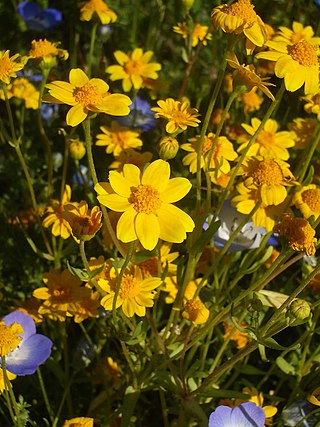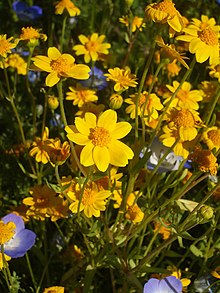
Lasthenia, commonly known as goldfields, is a genus of flowering plants family Asteraceae. The genus is named after Lasthenia of Mantinea, a cross-dressing female pupil of the ancient Greek philosopher Plato.

Lasthenia burkei is a rare species of flowering plant in the family Asteraceae known by the common names Burke's goldfields and Burke's baeria.

Helianthus bolanderi is a species of sunflower known by the common names Bolander's sunflower and serpentine sunflower. It is native to California and Oregon, where it grows mainly in mountainous areas, often in serpentine soils. It has been found from southwestern Oregon as well as in northern and central California as far south as Santa Cruz County, with reports of a few isolated populations in southern California.

Lasthenia californica is a species of flowering plant in the family Asteraceae known by the common name California goldfields. It is native to western North America.
Lasthenia chrysantha is a species of flowering plant in the family Asteraceae known by the common name alkalisink goldfields. It is endemic to the California Central Valley, where it grows in vernal pools and alkali flats.

Lasthenia ferrisiae is a species of flowering plant in the family Asteraceae known by the common name Ferris' goldfields. It is endemic to the California Central Valley, where it grows in vernal pools and alkali flats.

Lasthenia fremontii is a species of flowering plant in the family Asteraceae known by the common name Frémont's goldfields. It is endemic to the California Central Valley, where it grows in vernal pools and meadows.
Lasthenia glaberrima is a species of flowering plant in the family Asteraceae known by the common names smooth goldfields and rayless goldfields. It is native to western North America from British Columbia to California, where it grows in wet meadows and vernal pools.
Lasthenia microglossa is a species of flowering plant in the family Asteraceae known by the common name smallray goldfields. It is endemic to California, where it grows in shady areas in a number of habitats.

Bidens vulgata is a species of flowering plant in the family Asteraceae known by the common names big devils beggarticks and tall beggarticks. It is native to eastern and central North America from Nova Scotia to northern Georgia and as far west as the Rocky Mountains. It is an introduced species on the West Coast of North America as well as parts of Europe.
Blennosperma bakeri is a rare species of flowering plant in the daisy family known by the common names Baker's stickyseed and Sonoma sunshine.

Calycadenia multiglandulosa is a species of flowering plant in the family Asteraceae, known by the common names sticky calycadenia and sticky western rosinweed. It is endemic to California, where it is a common in the Coast Ranges and in the Sierra Nevada Foothills from Shasta County to Kern County.

Holocarpha virgata is a species of flowering plant in the family Asteraceae known by the common names yellowflower tarweed, pitgland tarweed, and narrow tarplant.
Lasthenia platycarpha is a species of flowering plant in the family Asteraceae known by the common name alkali goldfields. It is endemic to California, where it is known mainly from the Central Valley.
Lessingia micradenia is a rare species of flowering plant in the family Asteraceae known by the common name Mt. Tamalpais lessingia. It is endemic to the San Francisco Bay Area of California, where it occurs in areas with serpentine soils. The species is divided into two rare varieties, each with a limited occurrence on opposite sides of the Bay Area. Lessingia micradenia var. glabrata is found in several locations across Santa Clara County south of San Jose, while var. micradenia is known only from a few spots around Mount Tamalpais in Marin County.

Deinandra fasciculata, known by the common names clustered tarweed and fascicled spikeweed, is a species of flowering plant in the family Asteraceae native to western North America.

Centromadia pungens, the common spikeweed or common tarweed, is a species of North American plants in the tribe Madieae within the family Asteraceae. It is native to northern Baja California and the western United States. The plant is considered a noxious weed in parts of the Pacific Northwest.

Centromadia parryi, the pappose tarweed, is a species of plant in the tribe Madieae within the family Asteraceae. It is found in North America where it is native to California and, northern Baja California.

Crepis vesicaria is a European species of flowering plant in the family Asteraceae with the common name beaked hawk's-beard. It is native to the Western and Southern Europe from Ireland and Portugal east as far as Germany, Austria, and Greece. It became naturalized in scattered locations in North America.

Deinandra kelloggii, Kellogg's spikeweed or Kellogg's tarweed, is a North American species of plant in the tribe Madieae within the family Asteraceae. It is native to Baja California, southern and central California, and Arizona.














